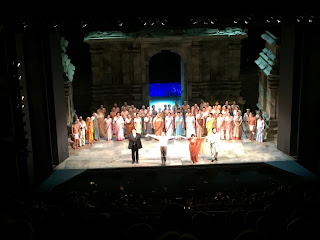David Geffen
Hall at Lincoln Center. Orchestra (Seat
R105, $69.50).
Program
Galantai Tankoc
(Dances of Galanta) (1933) by Kodaly (1882-1967).
Piano Concerto No.
2 in A major (1839-61) by Liszt (1811-86).
Vodnik (The
Water Goblin), Op.107 (1896) by Dvorak (1841-1904).
La Valse
(1919-20) by Ravel (1875-1937).
The headliner
for this concert is definitely Bronfman and the Liszt concerto. Afterall, the ticket says “Bronfman and
Liszt.” It was a worthwhile name for the
event.
I was still a
teenager, living in Hong Kong, when we first bought one of these multi-function
gadgets that served both as a radio and a cassette tape player. One of the first recordings I made off the
air was Liszt’s first piano concerto, and I remember playing it over and over,
and liking it more as I did so.
Structurally the
two piano concertos share at least one attribute: they are both played as one
uninterrupted piece. The Program Notes
says for this concerto many musicologists divide the six distinct sections into
three movements: (i) allegro sostenuto assai – allegro agitato assai; (ii)
allegro moderato; and (iii) allegro deciso, sempre allegro – marziale, un poco
meno allegro – allegro animato, with the further remark that (ii) is often
interpreted more as moderato than as allegro.
Both concertos
are of short duration, with No. 2 at about 21 minutes. Short though it may be, the pianist and the
orchestra still got quite a workout, and both did that brilliantly, with a “take-no-prisoners”
attitude. This was definitely the
highlight of the evening. Bronfman did
play an encore that showed his calm and melodic side. It was good, and Anne agreed his “touch” was
as good as Uchida’s.
Valcuha and Bronfman after performing Liszt's Piano Concerto No. 2.
The concert
began with Kodalys’s Galanta Dances.
Perhaps we do come to these concerts too often, as we also attended the
last series where this was played, in June, 2013. Naturally I had no memory of what the piece
sounded like. This time it sounded
simple and pleasant.
The two pieces
performed after the intermission were towards the “dark side.” Dvorak’s “The Water Goblin” was a symphonic
poem (I assume this is the same thing as a “tone poem”) based on Erben’s
work. The story is grisly: A girl is
pulled into the lake by the goblin and is made his wife, she longs to go back
to see her mother, the goblin lets her go but keeps their child behind, when
the girl doesn’t return, the goblin kills the child and throws the body onto
the cottage.
I must say the
music didn’t sound as dark as the story.
Evidently Dvorak wrote some musical phrases that mirror the words of the
poem, and the Program Notes cites one specific example with both the music and
the words. It is quite interesting, too
bad I can’t quite pronounce the words, although the melody – which as far I
could tell shows up quite late in the piece – was easy enough to catch. The melody used very early in the piece was
repeated much more often, I wish there was some description of it.
I heard Ravel’s
La Valse before, in 2008, and my blog entry then applies to what I heard
today. For this performance I heard more
of how repeated attempts to get to a “normal” waltz devolved into dissonance,
mirroring Ravel’s disillusion. However, “nothing
short of violent, terrifying, and bitterly final” is too strong a description
of what the music sounded like in the end.
Some scholar
announced in 2009 that the E-B-A notes in La Valse (Mi-Si-La in French) were used by
Ravel to reference his close friend Misia Sert, and they are interlinked to the
notes A and E at the beginning to denote Ravel (the two vowels in his name are
A and E.) This, the scholar asserts,
revealed a romantic attraction that hitherto had not been documented. I wonder how many Ph. D.s were awarded based
on discoveries of this kind.
The last (and
only) time I saw Valcuha I described his conducting as a bit exaggerated. Today I didn’t think so at all; and the
orchestra sounded great. I do wonder
about how this program hangs together.
The four pieces are on the short side (not to say they are easy to
perform,) and except for the despair in the second half of the program, they
seem to constitute a “sampler” of classical music. So while each piece was enjoyable on its own,
I do not have much a “takeaway” for the program in its entirety.
Interestingly,
the New York Times review expressed a similar sentiment on tonight’s
programming, contrasting thematic programming with randomness, and titling the review with the term "a quilt of composers." The reviewer was also critical of the “blatant
sounds” made by the woodwinds and brasses; well, having listened to the Sydney
Philharmonic a couple of times recently, I have a new admiration for how good
the New York Philharmonic players are.
Today's orchestra leader was Michelle Kim, who did a great job. I do wonder where Huang and Staples were; especially Huang, whom we had not seen on stage for a while. What gives?
We didn’t have
time for a proper dinner, so we had pizza before we made our way back to Jersey
City.




